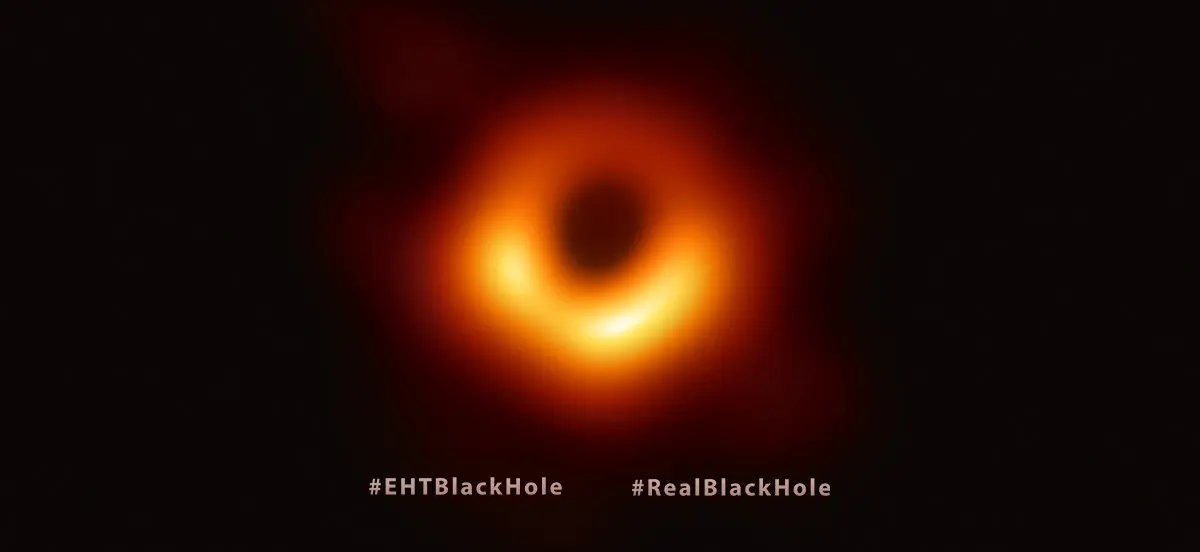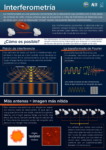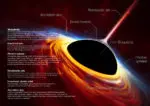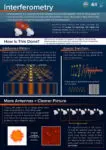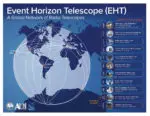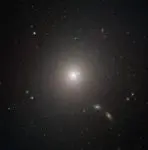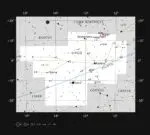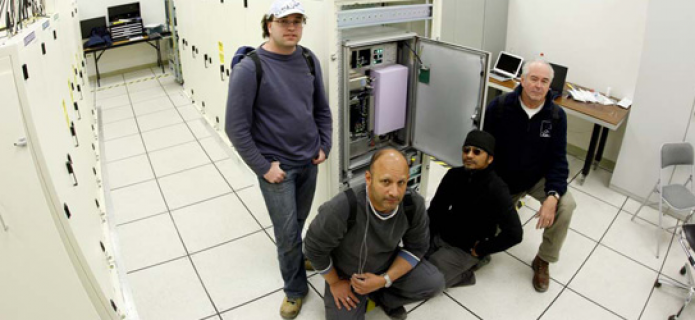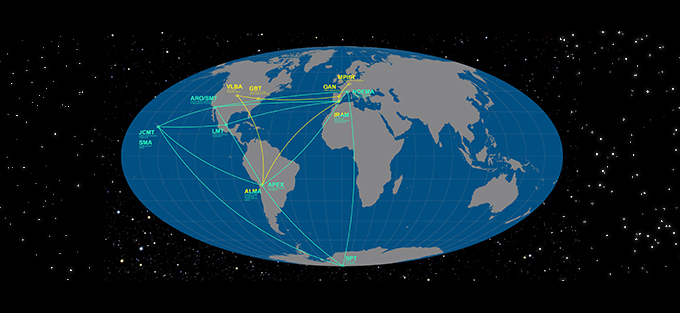Astronomers Capture the First Image of a Black Hole
Press Conference Streaming
The Event Horizon Telescope (EHT), a planet-scale array of eight ground-based radio telescopes forged through international collaboration, was designed to capture images of a black hole. Today, in coordinated press conferences across the globe, EHT researchers reveal that they have succeeded, unveiling the first direct visual evidence of a supermassive black hole and its shadow.
This breakthrough was announced today in a series of six papers published in a special issue of The Astrophysical Journal Letters. The image reveals the black hole at the center of Messier 87 [1. The shadow of a black hole is the closest we can come to an image of the black hole itself, a completely dark object from which light cannot escape. The black hole’s boundary — the event horizon from which the EHT takes its name — is around 2.5 times smaller than the shadow it casts and measures just under 40 billion km across.], a massive galaxy in the nearby Virgo galaxy cluster. This black hole resides 55 million light-years from Earth and has a mass 6.5-billion times that of the Sun [2. Supermassive black holes are relatively tiny astronomical objects — which has made them impossible to directly observe until now. As the size of a black hole’s event horizon is proportional to its mass, the more massive a black hole, the larger the shadow. Thanks to its enormous mass and relative proximity, M87’s black hole was predicted to be one of the largest viewable from Earth — making it a perfect target for the EHT.].
The EHT links telescopes around the globe to form an Earth-sized virtual telescope with unprecedented sensitivity and resolution [3. Although the telescopes are not physically connected, they are able to synchronize their recorded data with atomic clocks — hydrogen masers — which precisely time their observations. These observations were collected at a wavelength of 1.3 mm during a 2017 global campaign. Each telescope of the EHT produced enormous amounts of data – roughly 350 terabytes per day – which was stored on high-performance helium-filled hard drives. These data were flown to highly specialised supercomputers — known as correlators — at the Max Planck Institute for Radio Astronomy and MIT Haystack Observatory to be combined. They were then painstakingly converted into an image using novel computational tools developed by the collaboration.]. The EHT is the result of years of international collaboration, and offers scientists a new way to study the most extreme objects in the Universe predicted by Einstein’s general relativity during the centennial year of the historic experiment that first confirmed the theory [4. 100 years ago, two expeditions set out for Principe Island off the coast of Africa and Sobral in Brazil to observe the 1919 solar eclipse, with the goal of testing general relativity by seeing if starlight would be bent around the limb of the sun, as predicted by Einstein. In an echo of those observations, the EHT has sent team members to some of the world's highest and most isolated radio facilities to once again test our understanding of gravity.].
"We are giving humanity its first view of a black hole — a one-way door out of our Universe," said EHT project director Sheperd S. Doeleman of the Center for Astrophysics | Harvard & Smithsonian. "This is a landmark in astronomy, an unprecedented scientific feat accomplished by a team of more than 200 researchers."
Black holes are extraordinary cosmic objects with enormous masses but extremely compact sizes. The presence of these objects affects their environment in extreme ways, warping spacetime and super-heating any surrounding material.
"If immersed in a bright region, like a disc of glowing gas, we expect a black hole to create a dark region similar to a shadow — something predicted by Einstein’s general relativity that we’ve never seen before," explained chair of the EHT Science Council Heino Falcke of Radboud University, the Netherlands. "This shadow, caused by the gravitational bending and capture of light by the event horizon, reveals a lot about the nature of these fascinating objects and allowed us to measure the enormous mass of M87’s black hole."
Multiple calibration and imaging methods have revealed a ring-like structure with a dark central region — the black hole’s shadow — that persisted over multiple independent EHT observations.
"Once we were sure we had imaged the shadow, we could compare our observations to extensive computer models that include the physics of warped space, superheated matter and strong magnetic fields. Many of the features of the observed image match our theoretical understanding surprisingly well," remarks Paul T.P. Ho, EHT Board member and Director of the East Asian Observatory [5. The East Asian Observatory (EAO) partner on the EHT project represents the participation of many regions in Asia, including China, Japan, Korea, Taiwan, Vietnam, Thailand, Malaysia, India and Indonesia.]. "This makes us confident about the interpretation of our observations, including our estimation of the black hole’s mass."
Creating the EHT was a formidable challenge which required upgrading and connecting a worldwide network of eight pre-existing telescopes deployed at a variety of challenging high-altitude sites. These locations included volcanoes in Hawai and Mexico, mountains in Arizona and the Spanish Sierra Nevada, the Chilean Atacama Desert, and Antarctica.
The EHT observations use a technique called very-long-baseline interferometry (VLBI) which synchronizes telescope facilities around the world and exploits the rotation of our planet to form one huge, Earth-size telescope observing at a wavelength of 1.3mm. VLBI allows the EHT to achieve an angular resolution of 20 micro-arcseconds — enough to read a newspaper in New York from a sidewalk café in Paris [6. Future EHT observations will see substantially increased sensitivity with the participation of the IRAM NOEMA Observatory, the Greenland Telescope and the Kitt Peak Telescope.].
The telescopes contributing to this result were ALMA, APEX, the IRAM 30-meter telescope, the James Clerk Maxwell Telescope, the Large Millimeter Telescope Alfonso Serrano, the Submillimeter Array, the Submillimeter Telescope, and the South Pole Telescope [7. ALMA is a partnership of the European Southern Observatory (ESO; Europe, representing its member states), the U.S. National Science Foundation (NSF), and the National Institutes of Natural Sciences(NINS) of Japan, together with the National Research Council (Canada), the Ministry of Science and Technology (MOST; Taiwan), Academia Sinica Institute of Astronomy and Astrophysics (ASIAA; Taiwan), and Korea Astronomy and Space Science Institute (KASI; Republic of Korea), in cooperation with the Republic of Chile. APEX is operated by ESO, the 30-meter telescope is operated by IRAM(the IRAM Partner Organizations are MPG (Germany), CNRS (France) and IGN (Spain)), the James Clerk Maxwell Telescopeis operated by the EAO, the Large Millimeter Telescope Alfonso Serrano is operated by INAOE and UMass, theSubmillimeter Array is operated by SAO and ASIAA and the Submillimeter Telescope is operated by the Arizona Radio Observatory (ARO). The South Pole Telescope is operated by the University of Chicago with specialized EHT instrumentation provided by the University of Arizona.]. Petabytes of raw data from the telescopes were combined by highly specialised supercomputers hosted by the Max Planck Institute for Radio Astronomy and MIT Haystack Observatory.
The construction of the EHT and the observations announced today represent the culmination of decades of observational, technical, and theoretical work. This example of global teamwork required close collaboration by researchers from around the world. Thirteen partner institutions worked together to create the EHT, using both pre-existing infrastructure and support from a variety of agencies. Key funding was provided by the US National Science Foundation (NSF), the EU's European Research Council (ERC), and funding agencies in East Asia.
“ALMA is the largest millimeter wave telescope in the world and so was critical in the collaboration,” said ALMA Director Sean Dougherty; “It really helped to ensure high-quality calibration of the data to each of the other telescopes in the array, resulting in the fantastic images from the EHT.”
"We have achieved something presumed to be impossible just a generation ago," concluded Doeleman. "Breakthroughs in technology and the completion of new radio telescopes over the past decade enabled our team to assemble this new instrument — designed to see the unseeable."
Additional Information
This research was presented in a series of six papers published today in a special issue of The Astrophysical Journal Letters.
The EHT collaboration involves more than 200 researchers from Africa, Asia, Europe, North and South America. The international collaboration is working to capture the most detailed black hole images ever by creating a virtual Earth-sized telescope. Supported by considerable international investment, the EHT links existing telescopes using novel systems — creating a fundamentally new instrument with the highest angular resolving power that has yet been achieved.
The individual telescopes involved are; ALMA, APEX, the IRAM 30-meter Telescope, the IRAM NOEMA Observatory, the James Clerk Maxwell Telescope (JCMT), the Large Millimeter Telescope Alfonso Serrano (LMT), the Submillimeter Array (SMA), the Submillimeter Telescope (SMT), the South Pole Telescope (SPT), the Kitt Peak Telescope, and the Greenland Telescope (GLT).
The EHT Collaboration consists of 13 stakeholder institutes: the Academia Sinica Institute of Astronomy and Astrophysics, the University of Arizona, the University of Chicago, the East Asian Observatory, Goethe-Universitaet Frankfurt, Institut de Radioastronomie Millimétrique, Large Millimeter Telescope, Max Planck Institute for Radio Astronomy, MIT Haystack Observatory, National Astronomical Observatory of Japan, Perimeter Institute for Theoretical Physics, Radboud University and the Smithsonian Astrophysical Observatory.
The Atacama Large Millimeter/submillimeter Array (ALMA), an international astronomy facility, is a partnership of the European Organisation for Astronomical Research in the Southern Hemisphere (ESO), the U.S. National Science Foundation (NSF) and the National Institutes of Natural Sciences (NINS) of Japan in cooperation with the Republic of Chile. ALMA is funded by ESO on behalf of its Member States, by NSF in cooperation with the National Research Council of Canada (NRC) and the Ministry of Science and Technology (MOST) in Taiwan and by NINS in cooperation with the Academia Sinica (AS) in Taiwan and the Korea Astronomy and Space Science Institute (KASI).
ALMA construction and operations are led by ESO on behalf of its Member States; by the National Radio Astronomy Observatory (NRAO), managed by Associated Universities, Inc. (AUI), on behalf of North America; and by the National Astronomical Observatory of Japan (NAOJ) on behalf of East Asia. The Joint ALMA Observatory (JAO) provides the unified leadership and management of the construction, commissioning and operation of ALMA.
Links
- Paper I: The Shadow of the Supermassive Black Hole
- Paper II: Array and Instrumentation
- Paper III: Data processing and Calibration
- Paper IV: Imaging the Central Supermassive Black Hole
- Paper V: Physical Origin of the Asymmetric Ring
- Paper VI: The Shadow and Mass of the Central Black Hole
Images and videos
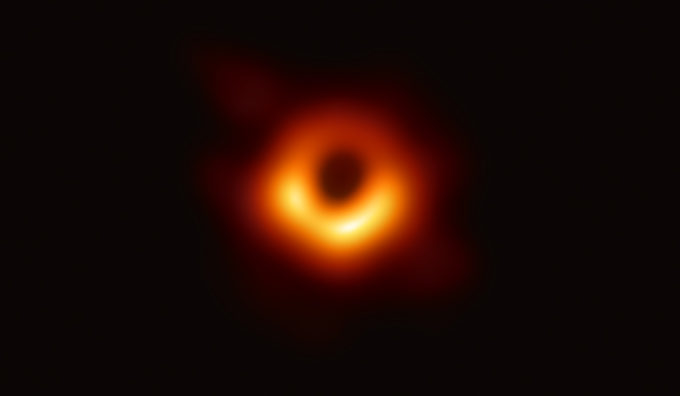
The Event Horizon Telescope (EHT) — a planet-scale array of eight ground-based radio telescopes forged through international collaboration — was designed to capture images of a black hole. In coordinated press conferences across the globe, EHT researchers revealed that they succeeded, unveiling the first direct visual evidence of the supermassive black hole in the center of Messier 87 and its shadow.
The shadow of a black hole seen here is the closest we can come to an image of the black hole itself, a completely dark object from which light cannot escape. The black hole’s boundary — the event horizon from which the EHT takes its name — is around 2.5 times smaller than the shadow it casts and measures just under 40 billion km across. While this may sound large, this ring is only about 40 microarcseconds across — equivalent to measuring the length of a credit card on the surface of the Moon.
Although the telescopes making up the EHT are not physically connected, they are able to synchronize their recorded data with atomic clocks — hydrogen masers — which precisely time their observations. These observations were collected at a wavelength of 1.3 mm during a 2017 global campaign. Each telescope of the EHT produced enormous amounts of data – roughly 350 terabytes per day – which was stored on high-performance helium-filled hard drives. These data were flown to highly specialized supercomputers — known as correlators — at the Max Planck Institute for Radio Astronomy and MIT Haystack Observatory to be combined. They were then painstakingly converted into an image using novel computational tools developed by the collaboration. Credit: EHT Collaboration
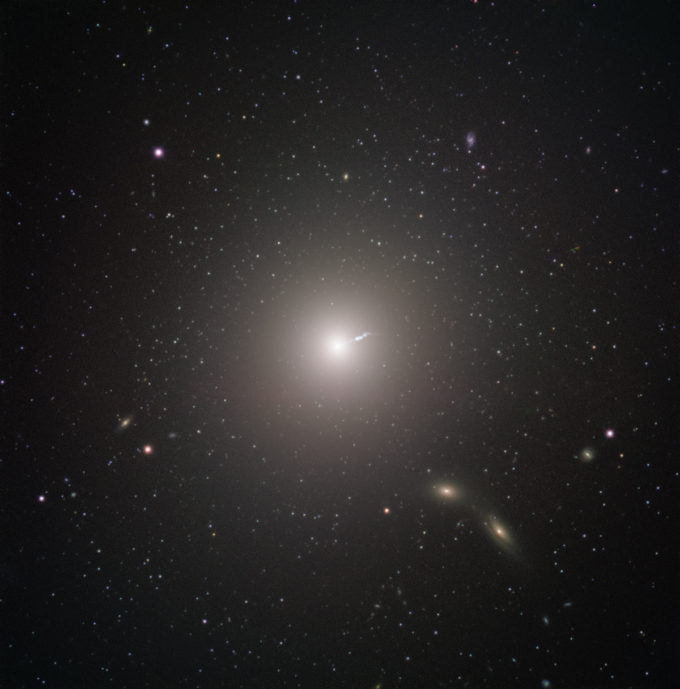
Messier 87 (M87) is an enormous elliptical galaxy located about 55 million light years from Earth, visible in the constellation Virgo. It was discovered by Charles Messier in 1781, but not identified as a galaxy until 20th Century. At double the mass of our own galaxy, the Milky Way, and containing as many as ten times more stars, it is amongst the largest galaxies in the local universe. Besides its raw size, M87 has some very unique characteristics. For example, it contains an unusually high number of globular clusters: while our Milky Way contains under 200, M87 has about 12,000, which some scientists theorize it collected from its smaller neighbors.
Just as with all other large galaxies, M87 has a supermassive black hole at its center. The mass of the black hole at the center of a galaxy is related to the mass of the galaxy overall, so it shouldn’t be surprising that M87’s black hole is one of the most massive known. The black hole also may explain one of the galaxy’s most energetic features: a relativistic jet of matter being ejected at nearly the speed of light.
The black hole was the object of paradigm-shifting observations by the Event Horizon Telescope. The EHT chose the object as the target of its observations for two reasons. While the EHT’s resolution is incredible, even it has its limits. As more massive black holes are also larger in diameter, M87's central black hole presented an unusually large target—meaning that it could be imaged more easily than smaller black holes closer by. The other reason for choosing it, however, was decidedly more Earthly. M87 appears fairly close to the celestial equator when viewed from our planet, making it visible in most of the Northern and Southern Hemispheres. This maximized the number of telescopes in the EHT that could observe it, increasing the resolution of the final image.
This image was captured by FORS2 on ESO’s Very Large Telescope as part of the Cosmic Gems program, an outreach initiative that uses ESO telescopes to produce images of interesting, intriguing or visually attractive objects for the purposes of education and public outreach. The program makes use of telescope time that cannot be used for science observations, and produces breathtaking images of some of the most striking objects in the night sky. In case the data collected could be useful for future scientific purposes, these observations are saved and made available to astronomers through the ESO Science Archive. Credit: ESO
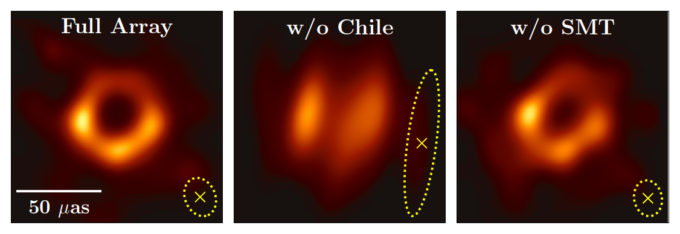
Comparison of the image of M87 taken by EHT with and without Chilean Telescopes (ALMA-APEX). Credit: EHT Collaboration
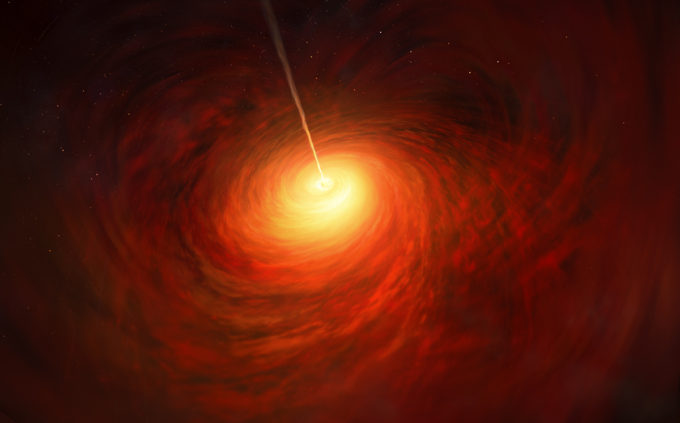
This artist’s impression depicts the black hole at the heart of the enormous elliptical galaxy Messier 87 (M87). This black hole was chosen as the object of paradigm-shifting observations by the Event Horizon Telescope. The superheated material surrounding the black hole is shown, as is the relativistic jet launched by M87’s black hole. Credit: ESO/M. Kornmesser
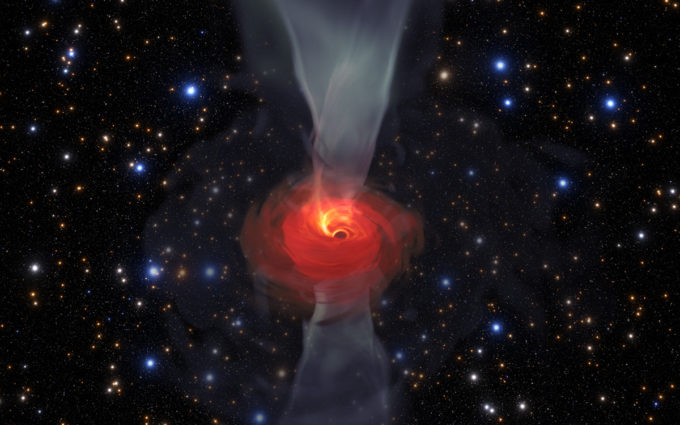
In anticipation of the first image of a black hole, Jordy Davelaar and colleagues built a virtual reality simulation of one of these fascinating astrophysical objects. Their simulation shows a black hole surrounded by luminous matter. This matter disappears into the black hole in a vortex-like way, and the extreme conditions cause it to become a glowing plasma. The light emitted is then deflected and deformed by the powerful gravity of the black hole. Credit: Jordy Davelaar et al./Radboud University/BlackHoleCam
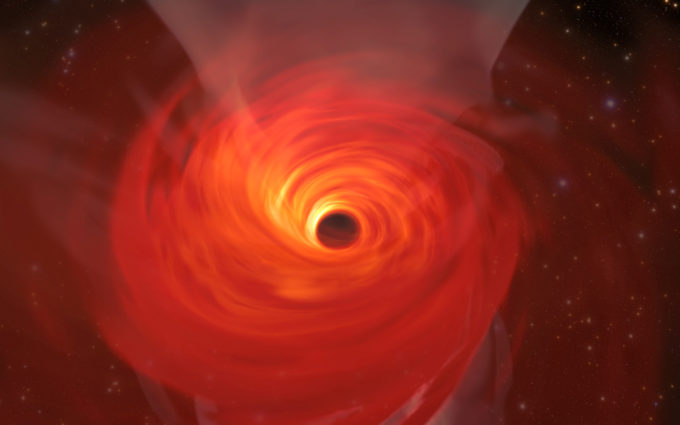
In anticipation of the first image of a black hole, Jordy Davelaar and colleagues built a virtual reality simulation of one of these fascinating astrophysical objects. Their simulation shows a black hole surrounded by luminous matter. This matter disappears into the black hole in a vortex-like way, and the extreme conditions cause it to become a glowing plasma. The light emitted is then deflected and deformed by the powerful gravity of the black hole. Credit: Jordy Davelaar et al./Radboud University/BlackHoleCam
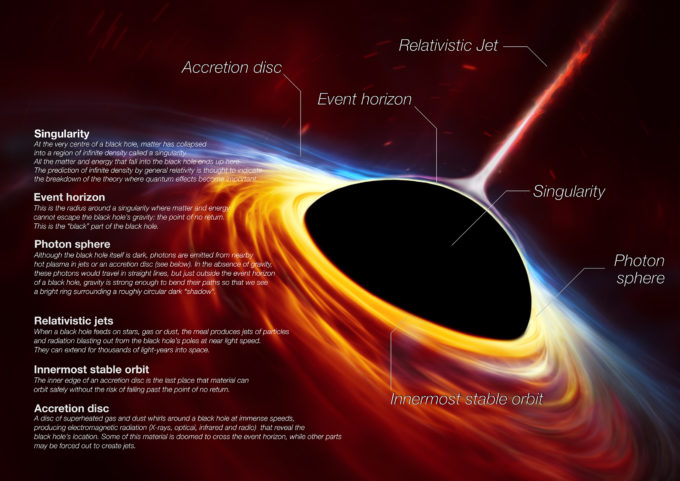
This artist’s impression depicts a rapidly spinning supermassive black hole surrounded by an accretion disc. This thin disc of rotating material consists of the leftovers of a Sun-like star which was ripped apart by the tidal forces of the black hole. The black hole is labelled, showing the anatomy of this fascinating object. Credit: ESO
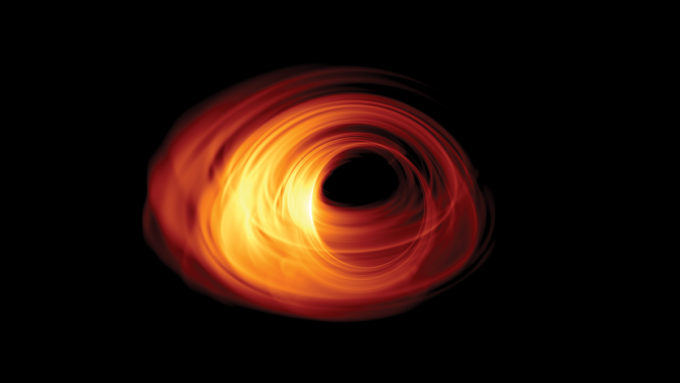
Simulated image of an accreting black hole. The event horizon is in the middle of the image, and the shadow can be seen with a rotating accretion disk surrounding it. Credit: Bronzwaer/Davelaar/Moscibrodzka/Falcke/Radboud University
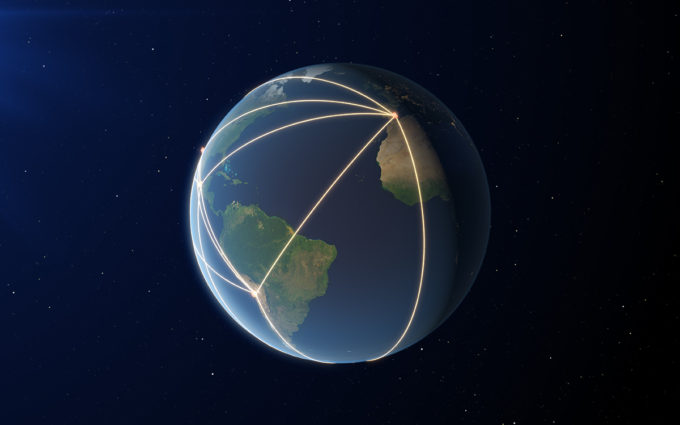
This image shows the locations of some of the telescopes making up the EHT, as well as the long baselines between the telescopes. Credit: ESO/ L. Calçada
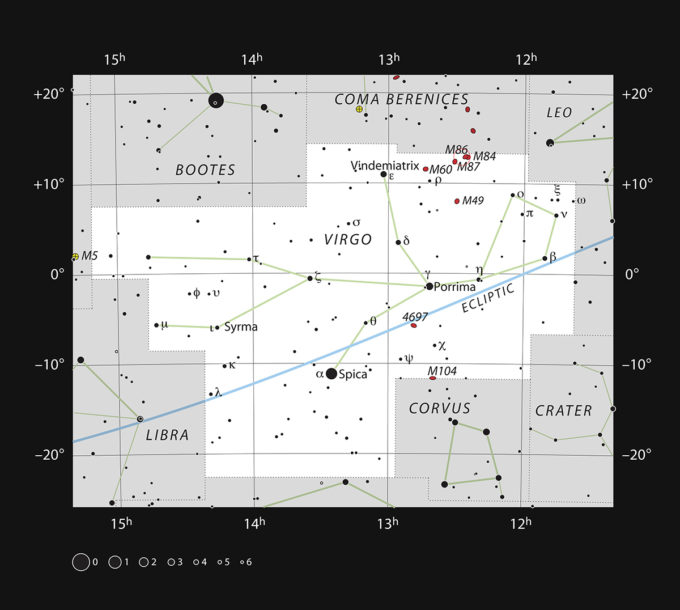
This chart shows the position of giant galaxy Messier 87 in the constellation of Virgo (The Virgin). The map shows most of the stars visible to the unaided eye under good conditions. Credit: ESO, IAU and Sky & Telescope
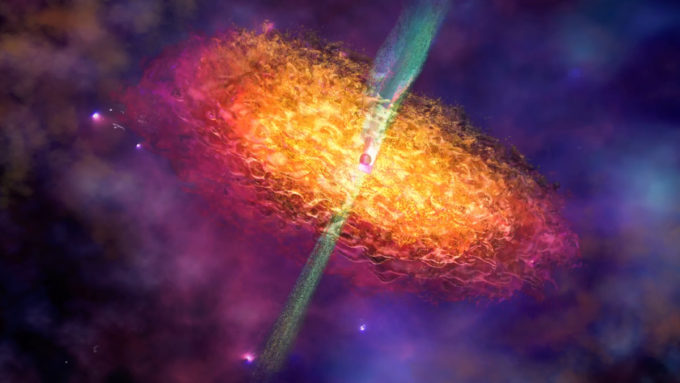
This artist’s impression depicts the surroundings of a black hole, showing an accretion disc of superheated plasma and a relativistic jet. Credit: Nicolle R. Fuller/NSF
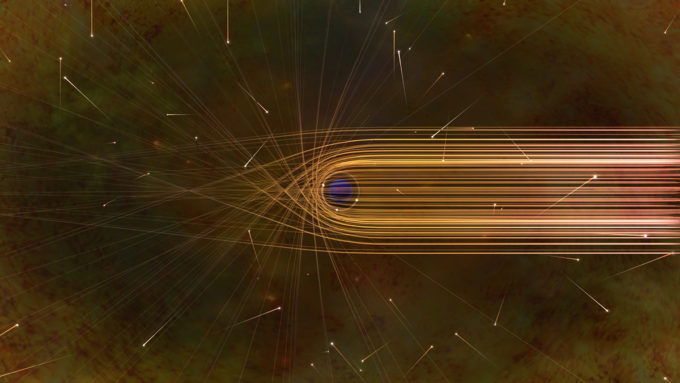
This artist’s impression depicts the paths of photons in the vicinity of a black hole. The gravitational bending and capture of light by the event horizon is the cause of the shadow captured by the Event Horizon Telescope. Credit: Nicolle R. Fuller/NSF
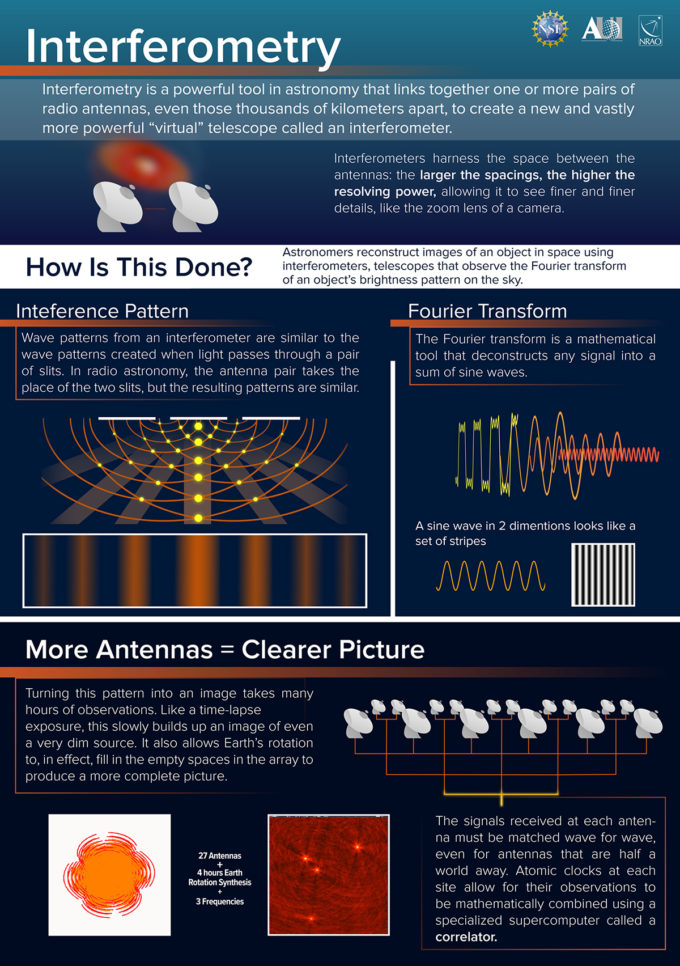
This poster from the NRAO explains some of the key concepts in interferometry, the breakthrough that made the Event Horizon Telescope observations of M87’s black hole possible. Credit: NRAO/AUI/NSF; S. Dagnello
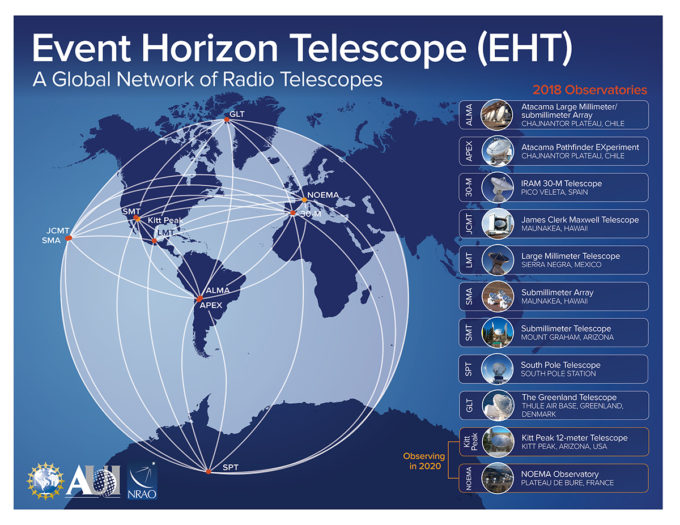
This diagram shows the location of the telescopes used in the 2017 EHT observations of M87. Credit: NRAO
In the Shadow of a Black Hole. The Event Horizon Telescope (EHT) — a planet-scale array of eight ground-based radio telescopes forged through international collaboration — was designed to capture images of a black hole. In coordinated press conferences across the globe, EHT researchers revealed that they succeeded, unveiling the first direct visual evidence of a supermassive black hole and its shadow. This 17-minute film explores the efforts that led to this historic image, from the science of Einstein and Schwarzschild to the struggles and successes of the EHT collaboration. Credit:ESO
Zooming in to the Heart of Messier 87. The Event Horizon Telescope (EHT) — a planet-scale array of eight ground-based radio telescopes forged through international collaboration — was designed to capture images of a black hole. In coordinated press conferences across the globe, EHT researchers revealed that they succeeded, unveiling the first direct visual evidence of a supermassive black hole and its shadow. This zoom video starts with a view of ALMA and zooms in on the heart of M87, showing successively more detailed observations and culminating in the first direct visual evidence of a supermassive black hole’s shadow. Credit: ESO/L. Calçada, Digitized Sky Survey 2, ESA/Hubble, RadioAstron, De Gasperin et al., Kim et al., EHT Collaboration. Music: niklasfalcke
Simulation of a Supermassive Black Hole. In anticipation of the first image of a black hole, Jordy Davelaar and colleagues built a virtual reality simulation of one of these fascinating astrophysical objects. Their simulation shows a black hole surrounded by luminous matter. This matter disappears into the black hole in a vortex-like way, and the extreme conditions cause it to become a glowing plasma. The light emitted is then deflected and deformed by the powerful gravity of the black hole. Credit: Jordy Davelaar et al./Radboud University/BlackHoleCam
Artist’s impression of the Black Hole at the heart of M87. This artist’s impression depicts the black hole at the heart of the enormous elliptical galaxy M87. This black hole was chosen as the object of paradigm-shifting observations by the Event Horizon Telescope. The superheated material surrounding the black hole is shown, as is the relativistic jet launched by M87’s black hole. Credit: ESO/M. Kornmesser
The EHT, a Planet-Scale Array This animation shows the locations of some of the telescopes making up the EHT, as well as the long baselines between the telescopes. Credit:ESO/ L. Calçada
Contacts
-
Shep Doeleman
Event Horizon Telescope DirectorCenter for Astrophysics | Harvard & SmithonianCambridge, Massachusetts, USAPhone: +1 617 496 7762Email: [email protected] -
Heino Falcke
Chair of the EHT Science Council, Radboud University -
Calum Turner
ESO Assistant Public Information Officer -
Masaaki Hiramatsu
Education and Public Outreach Officer, NAOJ Chile -
Charles E. Blue
Public Information OfficerNational Radio Astronomy Observatory Charlottesville, Virginia - USAPhone: +1 434 296 0314Cel: +1 202 236 6324Email: [email protected]
